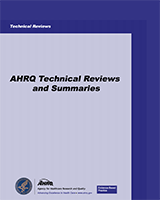NCBI Bookshelf. A service of the National Library of Medicine, National Institutes of Health.
Structured Abstract
Substantial evidence suggests that there is a wide gap between evidence-based best practices and those treatment practices actually used in day-to-day clinical medicine. To bring data to bear on this “quality gap” and the opportunities that exist to bridge it, the Agency for Healthcare Research and Quality (AHRQ) engaged the Stanford-UCSF Evidence-based Practice Center (EPC) to compile a critical analysis of the existing literature on quality improvement (QI) strategies for a selection of 20 disease and practice priorities identified in a 2003 Institute of Medicine report.
In Volume 1 of Closing the Quality Gap, we provide an overview of our methods and the theoretical underpinnings of the field, which we will rely on to review and analyze the literature on the quality gap in a number of the IOM-identified priority areas that will appear in subsequent volumes. We describe the genesis of the quality implementation field, providing some historical perspective on the science of translating research into practice. We then set forth our methodology: our reviews generally are restricted to studies that are likely to have strong validity (randomized controlled trials, well controlled before-after studies, and interrupted time series studies). To ensure consistency across our reviews, we introduce a taxonomy for nine QI strategies (provider reminder systems; facilitated relay of clinical data to providers; audit and feedback; provider education; patient education; promotion of self-management; patient reminders; organizational change; and financial, regulatory, or legislative incentives).
We hope the volumes in this series will be an essential source of accessible and critical analyses of the evidence regarding QI strategies that can help close the quality gap.
Contents
Managing Editor: Amy J Markowitz, JD.
Prepared for: Agency for Healthcare Research and Quality, U.S. Department of Health and Human Services.1 Contract No. 290-02-0017. Prepared by: Stanford-UCSF Evidence-based Practice Center.
Suggested citation:
Shojania KG, McDonald KM, Wachter RM, Owens DK. Closing The Quality Gap: A Critical Analysis of Quality Improvement Strategies, Volume 1—Series Overview and Methodology. Technical Review 9 (Contract No. 290-02-0017 to the Stanford University-UCSF Evidence-based Practices Center). AHRQ Publication No. 04-0051-1. Rockville, MD: Agency for Healthcare Research and Quality. August 2004.
- 1
540 Gaither Road, Rockville, MD 20850. www
.ahrq.gov
- NLM CatalogRelated NLM Catalog Entries
- Review Closing the Quality Gap: A Critical Analysis of Quality Improvement Strategies (Vol. 3: Hypertension Care)[ 2005]Review Closing the Quality Gap: A Critical Analysis of Quality Improvement Strategies (Vol. 3: Hypertension Care)Walsh J, McDonald KM, Shojania KG, Sundaram V, Nayak S, Davies S, Lewis R, Mechanic J, Sharp C, Henne M, et al. 2005 Jan
- Review Closing the Quality Gap: A Critical Analysis of Quality Improvement Strategies (Vol. 6: Prevention of Healthcare–Associated Infections)[ 2007]Review Closing the Quality Gap: A Critical Analysis of Quality Improvement Strategies (Vol. 6: Prevention of Healthcare–Associated Infections)Ranji SR, Shetty K, Posley KA, Lewis R, Sundaram V, Galvin CM, Winston LG. 2007 Jan
- Review Closing the Quality Gap: A Critical Analysis of Quality Improvement Strategies (Vol. 2: Diabetes Care)[ 2004]Review Closing the Quality Gap: A Critical Analysis of Quality Improvement Strategies (Vol. 2: Diabetes Care)Shojania KG, Ranji SR, Shaw LK, Charo LN, Lai JC, Rushakoff RJ, McDonald KM, Owens DK. 2004 Sep
- Closing the quality gap: revisiting the state of the science (vol. 6: prevention of healthcare-associated infections).[Evid Rep Technol Assess (Full ...]Closing the quality gap: revisiting the state of the science (vol. 6: prevention of healthcare-associated infections).Mauger Rothenberg B, Marbella A, Pines E, Chopra R, Black ER, Aronson N. Evid Rep Technol Assess (Full Rep). 2012 Nov; (208.6):1-578.
- Review Refinement of the HCUP Quality Indicators[ 2001]Review Refinement of the HCUP Quality IndicatorsDavies SM, Geppert J, McClellan M, McDonald KM, Romano PS, Shojania KG. 2001 May
- Closing the Quality Gap: A Critical Analysis of Quality Improvement Strategies (...Closing the Quality Gap: A Critical Analysis of Quality Improvement Strategies (Vol. 1: Series Overview and Methodology)
Your browsing activity is empty.
Activity recording is turned off.
See more...
